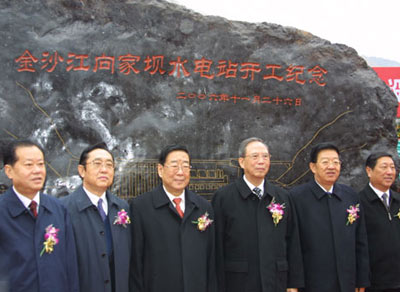| Home / Environment / Spotlight on | Tools: Save | Print | E-mail | Most Read |
| Hydropower Stations Dot Yangtze River |
| Adjust font size: |
A thousand kilometers upstream from the Three Gorges Project, China continues to throw up hydropower stations on the Yangtze. Construction began Sunday on the 6-million kw Xiangjiaba hydropower facility, the second on this section of the Yangtze after earthworks began on the Xiluodu project last year. The section of the Yangtze that flows between Yushu in Qinghai Province and Yibin in Sichuan Province is often called the Jinsha River and, before long, it will be dotted with hydropower developments. Jinsha means golden sand in Chinese, and the Jinsha River is said to have produced "golden sand" since ancient times. Addressing a ceremony to mark the start of construction on Sunday, Chinese Vice Premier Zeng Peiyan emphasized the need to consider all aspects of the Xiangjiaba development, including its impact on sustainable development. Hydroelectric projects need to be managed in an orderly manner, residents forced to relocate need to be properly looked after, the environment needs to be protected and thought given to preventing and controlling natural disasters, said Zeng. He reminded developers that quality and safety are fundamental principles in hydropower developments. Zeng said more use should be made of modern technology in these kinds of project. Zhang Guobao, vice minister of the National Development and Reform Commission, said the Xiangjiaba and Xiluodu projects would help the nation exploit the rich hydroelectric resources on the Jinsha River. The China Yangtze River Three Gorges Project Development Corporation has plans to build 22 more hydropower stations on the Yangtze, including two more -- Baihetan and Wudongde hydropower stations -- on the lower reaches of the Jinsha River section. According to Li Yong'an, general manager of the China Yangtze River Three Gorges Project Development Corporation, developer of all the projects, a feasibility study for the 12 million kw Baihetan hydropower station has been completed and approved by experts. Work has also started on a feasibility study for the Wudongde hydropower station. Construction of the two hydropower stations is expected to start in 2009 and be completed by 2020. The four hydropower stations will have a combined capacity of 38.5 million kw upon completion, said Li, but the potential hydroelectric capacity of this 2,300-km section of the Yangtze is estimated at 112 million kw. Workers will start to dam the Jinsha River in 2008. The Xiangjiaba hydropower station -- located near Yibin – will displace 88,000 residents from six counties in southwest China's Yunnan and Sichuan provinces. Some 8,000 people have already been resettled. Budgeted to cost 43.4 billion yuan (about US$5.43 billion), it will be completed in 2015 and will be able to generate 30.7 billion kw/hour of electricity a year. In addition to providing power, the project will also play a role in flood control, farmland irrigation, will improve navigation and have a positive effect on the environment, according to Li. Electricity generated by hydropower stations on the Jinsha River will mainly be sold to China's eastern, southern and central regions. Statistics provided by the Chinese Ministry of Water Resources show that Chinese rivers could generate 540 million kw of hydroelectric power capacity. Currently, only one fifth of the total is being exploited, as compared with three fifths in developed nations. Wang Shucheng, Minister of Water Resources, insists that China will make vigorous efforts to tap its rich hydroelectric resources. By 2020, the country will have tapped 46 percent of its hydropower resources and raised capacity to 250 million kw.
(Xinhua News Agency November 27, 2006) |
| Tools: Save | Print | E-mail | Most Read |
 |
| Related Stories |
|
|||



